

Grade 8 ELA Module 2B. In this second module, students read and analyze Shakespeare’s A Midsummer Night’s Dream.
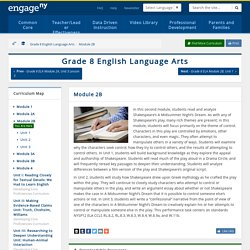
As with any of Shakespeare’s play, many rich themes are present; in this module, students will focus primarily on the theme of control. Characters in this play are controlled by emotions, other characters, and even magic. They often attempt to manipulate others in a variety of ways. Students will examine why the characters seek control, how they try to control others, and the results of attempting to control others. In Unit 1, students will build background knowledge as they explore the appeal and authorship of Shakespeare. In Unit 2, students will study how Shakespeare drew upon Greek mythology as he crafted the play within the play. Basic Sonnet Forms. Nelson Miller From the Cayuse Press Writers Exchange Board Return to Sonnet Central home.

A sonnet is fundamentally a dialectical construct which allows the poet to examine the nature and ramifications of two usually contrastive ideas,emotions, states of mind, beliefs, actions, events, images, etc., byjuxtaposing the two against each other, and possibly resolving or justrevealing the tensions created and operative between the two. O. K., so much for the fancy language. I. The basic meter of all sonnets in English is iambic pentameter (basic information on iambic pentameter),although there have been a few tetrameter and even hexametersonnets, as well. In Search of Shakespeare . Language Arts: Shakespeare's Sonnets. Introduction One of the difficulties teachers face when they teach Shakespeare is language accessibility.

Twenty-first century students simply have difficulty understanding the words, and so they miss the meaning of his plays and sonnets. This is no small loss. Thus, it is a teacher's responsibility to help students not only understand the language but also to empower them, so that when faced with difficult texts they feel as if they can, with a little effort, appreciate what Shakespeare is saying. However, the lesson can be easily tailored to a teacher's specific students. How to Write a Sonnet - Types of Poems. This page talks about how to write a sonnet and offers some poem starters for writing your own.
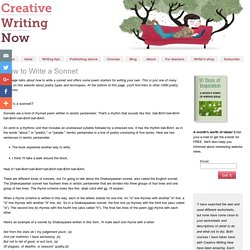
This is just one of many pages on this website about poetry types and techniques. At the bottom of this page, you'll find links to other CWN poetry resources. Writing a Group Sonnet. Words and Phrases Coined by Shakespeare. Words and Phrases Coined by Shakespeare NOTE: This list (including some of the errors I originally made) is found in several other places online.
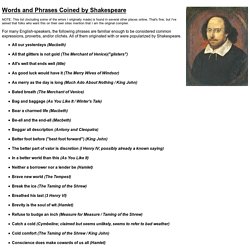
That's fine, but I've asked that folks who want this on their own sites mention that I am the original compiler. For many English-speakers, the following phrases are familiar enough to be considered common expressions, proverbs, and/or clichés. 'hades' pitch' by rita dove (poetry reading) by SpokenVerse - UK Teaching Resources. The 'why' and 'how' of teaching sonnets - Folger Education. Earlier this week, we invited you to share our sonnet-writing contest with your students.

And we hope you do! Why teach Shakespeare’s sonnets? Exploring Shakespeare’s sonnets can be a good way to introduce students to his language.Many ideas and themes in the sonnets also appear in Shakespeare’s plays and can be useful lead-ins. For instance, looking at individual sonnets in Romeo and Juliet can be a door into the play.The strictures of the sonnet form can inspire creativity in students. Teaching Modules. Lesson Plans & Teaching Materials - English-Speaking Union of the United States. Lesson Plans & Teaching Materials Here are lesson plans on monologues and sonnets designed to help you implement the Competition in your classroom and beyond.

They were created by Susan Biondo-Hench, our Competition Teacher Liaison. Week 1: Getting to Know Monologues and the ESU National Shakespeare Competition Aims: Introduce students to the English-Speaking Union National Shakespeare Competition, share several videos of successful monologues from the Competition, and have the students select and begin to explore their own monologues. Monologue Viewing Guide Week 2: Taking the Monologue Out for a WalkAims: Students continue to research the monologue and begin the physical work of putting the monologue up on its feet.
Glogin?URI= Sonnet Writing Assignment. Teaching Sonnets Lesson Plan. Lesson Plan for Teaching Sonnets Who knew teaching sonnets could be this great?
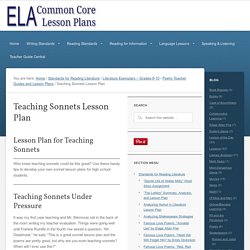
Use these handy tips to develop your own sonnet lesson plans for high school students. Teaching Sonnets Under Pressure It was my first year teaching and Mr. Sternman sat in the back of the room writing my teacher evaluation. William Shakespeare, Romeo And Juliet and Shakespeare Sonnets. Living Iambic Pentameter-Folger Shakespeare Library: Shakespeare in American Life. Video by GVI, Inc.
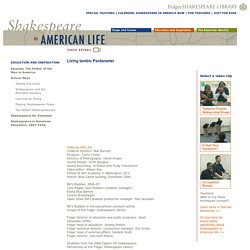
Creative Director: Bob Burnett Producer: Curtis Croley Director of Photography: David Krupin Sound Design: Scott Burgess Sound Recording: Al Faison and Trudy Hutcherson Video editor: Allison Rae Filmed at KEY Academy in Washington, DC’s historic Blue Castle building, December 2006. Bill’s Buddies, 2006–07: Cam Magee (also Buddies company manager) Elisha Efua Bartels Clinton Brandhagen Jason Stiles Bill’s Buddies production manager: Niki Jacobsen Bill’s Buddies is the educational outreach acting troupe of the Folger Shakespeare Library. Shakespearean Sonnets. |Style, Form, and Rhythm| |Sonnet 18| |Sonnet 29| |Sonnet 55| |Sonnet 73| |Sonnet 116| |Sonnet 130| |Sonnet 146| Style, Form, and Rhythm Active ShakespeareIn "SonnetQuiz," add the final word to the heroic couplet.
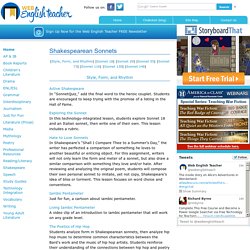
Students are encouraged to keep trying with the promise of a listing in the Hall of Fame. Exploring the SonnetIn this technology-integrated lesson, students explore Sonnet 18 and an Italian sonnet, then write one of their own. This lesson includes a rubric. Hate to Love SonnetsIn Shakespeare’s "Shall I Compare Thee to a Summer’s Day," the writer has perfected a comparison of something he loves to another beautiful or enticing object. Iambic PentameterJust for fun, a cartoon about iambic pentameter. Discovering Traditional Sonnet Forms. ReadWriteThink couldn't publish all of this great content without literacy experts to write and review for us. If you've got lessons plans, videos, activities, or other ideas you'd like to contribute, we'd love to hear from you. More Find the latest in professional publications, learn new techniques and strategies, and find out how you can connect with other literacy professionals.
More Teacher Resources by Grade Your students can save their work with Student Interactives. More. Sonnets: Lesson Plans. Active ShakespeareIn "SonnetQuiz," add the final word to the heroic couplet. Students are encouraged to keep trying with the promise of a listing in the Hall of Fame. Exploring the SonnetIn this technology-integrated lesson, students explore Shakespeare's Sonnet 18 and an Italian sonnet, then write one of their own. This lesson includes a rubric. Teachers Shake Up Shakespeare with Digital Media.
"My name is Macbeth / I'm the Thane of Glamis. / I might not be the king / but I'm still hella famous. " Terry, a student at Toronto's York Mills Collegiate Institute, wrote that rap for his tenth-grade English class as part of a music video depicting William Shakespeare's famous play Macbeth. "We got 100 percent on it! " Terry recalls. More important, adapting the play into a modern rap helped Terry understand the Bard's old English prose. Project Based Learning Unit. Shaking the Shakespeare Blues. Best Shakespeare Sites Absolute Shakespeare offers summaries overviews, some criticism, and text of the plays. Focus is on the more frequently taught plays. BBC In Search of Shakespeare traces Shakespeare’s life in two parts. Early Years and Later Years (archived). Cummings Shakespeare Guides offer a varied mix of information written just for the site and links to scholarly resources.
Ed the Pathology Guy --Ed Friedlander has his own twistonseveral Shakespearean plays. The Bard Game. Shakespeare For Children — The Journey Mom. It was 10 o’clock at night, after a full day of touring New York City, and I worried that my youngest child would fall asleep during the production of Dream, an adaptation of A Midsummer Night’s Dream. Instead, he was on the edge of his seat guffawing with laughter. Actually, we were all laughing at that point.
The young cast of this Downtown Art production, under the direction of Ryan Gilliam, had put on a delightful performance. This comedic tale of romance and parental disobedience has been “infused with Celtic tales of mischief and magic.” Irish fairies snatch babies and use magic potions to redirect love and turn a man into a donkey. Our kids loved the show, even 8-year-old Alex. This was his first time seeing a full production of a Shakespearean play and I was concerned that he wouldn’t understand or enjoy the show. In truth, A Midsummer Night’s Dream is perhaps the most accessible Shakespearean play for children. A Teachers' Guide to websites, books, and films. Shakespeare and the Elizabethans.
Twelfth Night. MacBeth. Julius Caesar. Journal Prompts to Teach Shakespeare's Macbeth. Studying the works of William Shakespeare can be intimating for students. Their apprehension may stem from the difficulty of the language, the depth of themes, or perhaps just Shakespeare’s reputation as being difficult. Shakespeare need not incite panic in our students, however. I’ve found one approach that makes his works much more approachable: the use of journaling. The benefits of journaling are profound. Because there is no single “right” answer and it is generally informal in nature, journals build confidence in the writing process and contribute to emotional development.
In 1564, William Shakespeare was born on this day. Shakespeare in Circles. Life and Times. The "Soest" portrait.